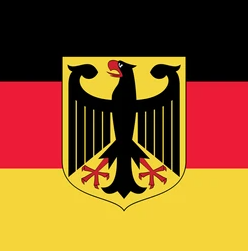Germany National Emblem reflects a rich cultural heritage and history of the country. The emblem of Germany, also known as the Federal Eagle, represents the country’s national identity, unity, and sovereignty. The emblem has undergone various changes throughout the years, reflecting the country’s evolving history and values. This article explores the history and symbolism of the Germany National Emblem, including its origin, design, and meaning.
What is the Germany National Emblem?
The Germany National Emblem, also known as the Federal Eagle, is the official symbol of the country. It is a coat of arms that depicts an eagle with its wings spread, facing right. The eagle is a heraldic symbol that has been used in various forms for centuries in Germany. The current design of the emblem was adopted in 1950, after the end of World War II, and reflects the values and aspirations of the German people.
History of the Germany National Emblem
The history of the Germany National Emblem can be traced back to the Holy Roman Empire, which existed from the 10th to the 19th century. The eagle was used as a symbol of imperial power and was often depicted with two heads to represent the dual nature of the Holy Roman Empire. After the collapse of the empire in the 19th century, the eagle continued to be used as a symbol of German nationalism and unity.
In 1919, after the end of World War I, the Weimar Republic adopted a new national emblem that featured a black, red, and gold tricolor flag with the eagle in the center. The eagle was facing left and had a wreath of oak leaves in its talons, symbolizing strength and endurance. This emblem was later banned by the Nazi regime, which replaced it with the swastika.
After the defeat of Nazi Germany in World War II, the country adopted a new constitution in 1949, which included a new national emblem. The eagle was again chosen as the symbol, but this time it faced right and held a wreath of oak leaves and a sword, symbolizing both strength and peace.
Design and Symbolism of the Germany National Emblem
The design of the Germany National Emblem is highly symbolic and reflects the values and aspirations of the German people. The eagle is a powerful and majestic bird that symbolizes strength, courage, and freedom. The spread wings of the eagle represent the country’s desire to fly high and achieve great things.
The eagle is also holding a wreath of oak leaves in its talons, which symbolizes strength and endurance. Oak trees are considered a symbol of the German nation and are highly valued for their durability and longevity.
The sword held by the eagle symbolizes both strength and peace. It represents the country’s commitment to defend its sovereignty and protect its people, while also promoting peace and stability in the world.
Significance of the Germany National Emblem
The Germany National Emblem holds great significance for the German people and is a symbol of their national identity and unity. It represents the country’s long and complex history, as well as its cultural heritage and values. The emblem is used on official documents, currency, and military insignia, and is recognized around the world as a symbol of Germany.
FAQs
- What is the origin of the Germany National Emblem?
The Germany National Emblem has its origins in the Holy Roman Empire, where the eagle was used as a symbol of imperial power.
- Why does the eagle face right in the Germany National Emblem?
The eagle faces right in the Germany National Emblem to symbolize the country’s desire to move forward and achieve great things.
- What is the significance of the oak leaves in the Germany National Emblem?
The oak leaves in the Germany National Emblem represent strength and endurance, and are a symbol of the German nation.
- What is the significance of the sword in the Germany National Emblem?
The sword in the Germany National Emblem symbolizes both strength and peace, representing the country’s commitment to defend its sovereignty while also promoting peace and stability.
- How has the Germany National Emblem evolved over time?
The Germany National Emblem has undergone various changes throughout history, reflecting the country’s evolving values and aspirations. The current design, adopted in 1950, features an eagle with its wings spread, facing right, holding a wreath of oak leaves and a sword.
Conclusion
The Germany National Emblem is a powerful symbol of the country’s national identity and unity. Its design and symbolism reflect the German people’s cultural heritage, values, and aspirations. The emblem has evolved over time, but its significance remains unchanged. As a symbol of strength, endurance, and peace, the Germany National Emblem represents the best of what the country has to offer, both to its own citizens and to the world at large.
References
- “The German National Emblem”. Federal Foreign Office of Germany. https://www.auswaertiges-amt.de/en/aussenpolitik/laenderinformationen/deutschland-node/flagge-wappen-212308
- “National emblem of Germany”. Encyclopædia Britannica. https://www.britannica.com/topic/national-emblem-of-Germany
- “Germany – Coat of Arms”. World Statesmen. https://www.worldstatesmen.org/Germany.htm#Coat
